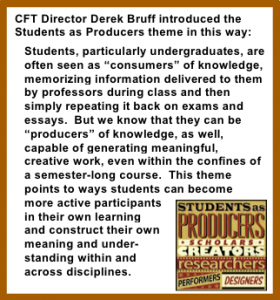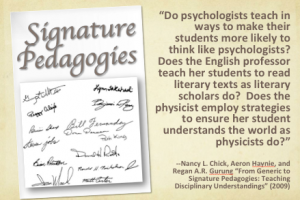Students as Producers of Disciplinary Habits
by Nancy Chick, CFT Assistant Director
The CFT’s recent Teaching Visit hosted by Phil Ackerman-Lieberman illustrated our 2013-14 theme of Students as Producers in a way that’s different from our previous examples.  These other instances typically focus on specific course assignments that engage students in actively creating something, often directing their work toward authentic audiences beyond the professor (e.g., blogs, a children’s book or film script, activism projects, service learning projects, videos). Many of these assignments occur toward the end of the semester as capstone activities. Phil’s class embodies this theme in its fundamental approach to learning, positioning students in the role of producer of disciplinary knowledge and activities from day one.
These other instances typically focus on specific course assignments that engage students in actively creating something, often directing their work toward authentic audiences beyond the professor (e.g., blogs, a children’s book or film script, activism projects, service learning projects, videos). Many of these assignments occur toward the end of the semester as capstone activities. Phil’s class embodies this theme in its fundamental approach to learning, positioning students in the role of producer of disciplinary knowledge and activities from day one.
The first sentence in his Introduction to Jewish Studies syllabus informs students that they will be “discussing just what it is that scholars of Jewish Studies do.” He goes on: “Using brief articles from current scholarship, we will explore the methods and questions in the field; and we will read selections of primary sources from the Jewish past in tandem with these articles to see how academic writers and thinkers integrate that past with scholarly trends in the present” (emphases added).
There’s a name for Phil’s approach: signature pedagogies, or teaching in ways that get students to “understand and practice disciplinary ways of thinking or habits of mind” (Chick, Haynie, & Gurung, 2009, p. 2). In the post-class discussion with his visitors,  Phil confirmed that his “vision of Introduction to Jewish Studies” revolves around the “methodologies of Jewish Studies scholars” and the “big questions” of the field. What does this vision look like? It’s the sum of many small but significant activities:
Phil confirmed that his “vision of Introduction to Jewish Studies” revolves around the “methodologies of Jewish Studies scholars” and the “big questions” of the field. What does this vision look like? It’s the sum of many small but significant activities:
- On the day of our visit, Phil guided students in “unpacking” sections of a scholarly article, closely reading for its argument, assumptions, and interactions with previous arguments in the field. To be clear, Phil simply guided the students who did the actual work. What does it mean to read like a Jewish Studies scholar? Very much like what we observed in his class.
- His students also practice the common scholarly act of tracking down articles. Of course, this step is a typical component of all research assignments, but Phil’s students do it as preparation for nearly every class session. Rather than putting the secondary materials on OAK or e-reserve, he simply includes the citation on the syllabus, and students are tasked with retrieving each article directly from the library or through interlibrary loan. Think about it: scholars regularly come upon a citation and hunt down the source using a variety of tools. Rarely a linear process, it requires trouble-shooting and familiarity with at least a few research paths. Outside of research assignments, we do this work and provide the articles for undergraduates, keeping them from practicing this authentic disciplinary routine. Finding articles based solely on citations becomes habit in Phil’s class.
- In the list of assignments on his syllabus, students learn that they’ll be writing two book reviews on “current works of scholarship in Jewish studies.” Their selections must be published by academic presses and address “contemporary controversies in Jewish studies.” What do these reviews look like? He tells students to find published examples, modeling their work after the authentic work in the field. Even further, in the discussion of the article at the center of the class period we visited, Phil mentioned a few times that he’d written a review of this book or read a review of that book. These brief asides make clear that the book review is a significant genre facilitating the ongoing conversation within the field, not simply an exercise for a college class.
- He peppered the session with a sense of familiarity with the scholars the class was reading—not in the spirit of name-dropping but instead to “humanize the scholars,” he explained later. He wants his students to recognize that real men and women are doing the work, and not in isolation but within a community.
- At the end of the semester, Phil’s students present brief versions of their papers “in a conference-style setting,” a simulation of what scholars in the field do. He explained, “I want the students to see the other students doing the work of Jewish Studies in a learning community.”
Instead of just presenting students with the results of the work done by the community of scholars in Jewish Studies, Phil’s introductory course creates such a nascent community doing this work themselves. I can think of no better way to introduce students to a discipline.
—-
For more information about signature pedagogies, refer to these resources:
 Shulman, Lee S. (2005) “Signature Pedagogies in the Professions.” Daedalus, 134, 52-59. After presenting the idea first in a plenary session at the 2005 conference of the International Society of the Scholarship of Teaching and Learning (ISSOTL), Shulman published his work in Daedalus.
Shulman, Lee S. (2005) “Signature Pedagogies in the Professions.” Daedalus, 134, 52-59. After presenting the idea first in a plenary session at the 2005 conference of the International Society of the Scholarship of Teaching and Learning (ISSOTL), Shulman published his work in Daedalus.- Calder, Lendol. (2008) ”Uncoverage: Toward a Signature Pedagogy for the History Survey.” Journal of American History. Calder was the first to bring Shulman’s notion of signature pedagogies to the academic disciplines.
- Gurung, Regan A.R., Nancy L. Chick, and Aeron Haynie. (2009) Exploring Signature Pedagogies: Approaches to Teaching Disciplinary Habits of Mind. Sterling, VA: Stylus. This book builds on Shulman and Calder by articulating signature pedagogies in a variety of academic disciplines. (Available at the CFT library. Read preview here.)

- Chick, Nancy L., Aeron Haynie, and Regan A.R. Gurung. (2012) Exploring More Signature Pedagogies: Approaches to Teaching Disciplinary Habits of Mind. Sterling, VA: Stylus. This second book extends the exploration of signature pedagogies to more academic disciplines, some interdisciplinary programs, and some of the professions. (Available at the CFT library.)
You can also schedule an individual consultation or department-wide workshop with me to discuss the concept of signature pedagogies and to develop strategies to apply in your classrooms.

Leave a Response